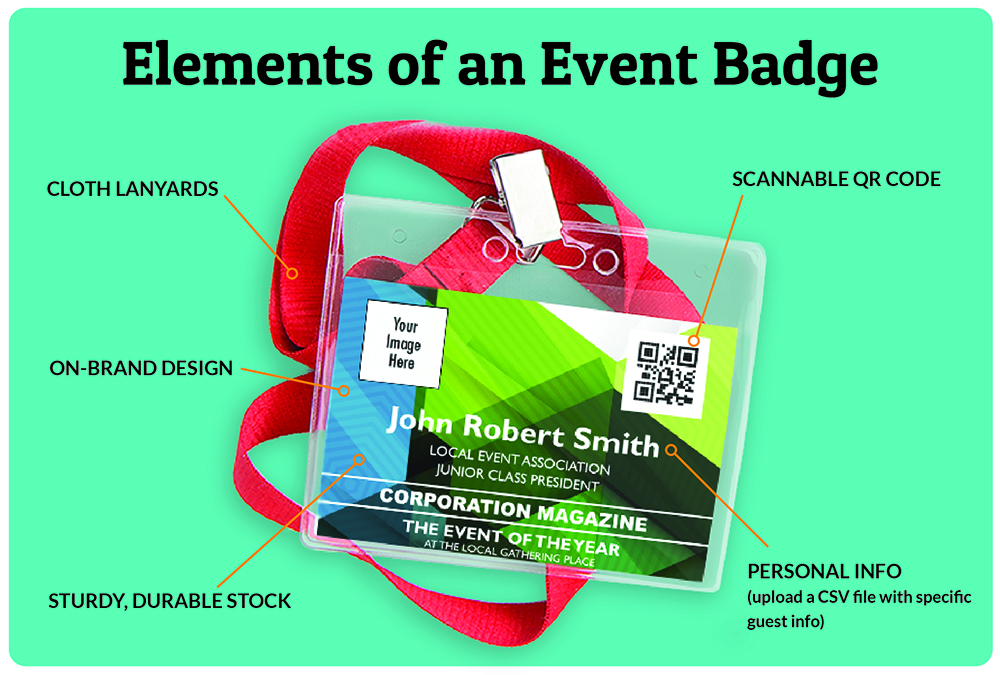All About Event Badge Design: Tips and Best Practices
3/13/2025
Imagine that you’re at an event or conference. Someone smiles and walks over to you. You know them, but you can’t remember their name. You start to panic. You might even think about avoiding them and heading for the food table. But if they have an event badge with their name in bold, you can relax and greet them by name. Custom event badges help reduce social anxiety and have other benefits:
- Provide touchless event entry thanks to the magic of barcodes/QR codes.
- Take some of the awkwardness out of networking (see above!).
- Make it easy to sort attendees into various groups.
- Help event staff determine access through visual ID/QR code scan.
- Enable guests to scan in for lunch, snacks, and cocktail hour.
- Supply data on what sessions or events guests are attending at your event.
- Offer an opportunity to reinforce your brand.
What Kind of Badge is Right for Your Event?
Event badges are available in various materials and sizes and are displayed via a lanyard worn around the neck or a bulldog clip. Your event, in part, determines the sort of event badge you’ll need. Here, we’ll go over the two most-used badge materials.
Paper Badges:
Usually printed on sturdy, thick card stock, paper badges are great for shorter events. You can extend their longevity by pairing them with vinyl badge holders.
Plastic Badges:
As you can imagine, plastic event badges are waterproof and very durable. Unfortunately, that sturdiness also means they’re a bit more expensive. The cost, however, is worth it if guests will be wearing them for days or outdoors, such as at a music festival.
Badge Size:
If you have vendors, staff, press, entertainment, speakers, VIPs, and general attendees, consider employing various badge sizes to differentiate the groups. For instance, you could use large conference badges for VIPs and talent, small for press and staff, medium for vendors, etc. Simultaneously, you can also introduce colors to differentiate guests through lanyards or on the badges themselves. Finally, if you add variable QR coding, you’ll be able to efficiently identify and track attendees and provide the proper access to everyone.
Design Best Practices
A great special event badge should sync with your company’s branding and be easy for attendees, vendors, and event staff to read. To that end, the following elements should be included in your design:
Attendee information: If the badge is for a trade show or conference, the name, title, and company should be clear. In most cases, this means the name is in the largest, boldest font, followed by the title and company. For other sorts of events, such as a VIP badge for a concert, only the name may be necessary.
Variable QR code and barcodes: This should be presented beneath the attendee information for easy scanning, check-in, and access control.
Branding: An event badge is an extension of your event and company’s brand. Thus, your logo and/or brand colors should be visible! Consider also including your social media handles. If that’s not possible on the front, and you aren’t using the back for sponsorship opportunities, display them on the back. A great way to do this is through a QR code—guests can scan it to access your site, social media links, and giveaways.
How to Design a Custom Badge

Option 1: Team up with a graphic designer
They’ll create event badge designs for your various attendee types and add whatever elements you need, such as logos, QR codes, and more. If you need a graphic designer, browse freelance sites such as Upwork and Fiverr. Alternatively, when you work with a professional online printing service like Eventgroove, you’ll generally have the option to work with a design professional. In our case, fees are affordable, and we offer a customer satisfaction guarantee on all print orders.
Option 2: Design and print badges yourself
If you’ve got design skills and a great home or office printer, DIY event badges are possible. However, keep in mind that each QR code/barcode must be crisp and clear, which can be challenging to achieve without professional printing. In addition, variable data can be difficult to efficiently and accurately manage yourself. An alternative would be to create a design using Adobe Photoshop or similar software, then upload your badge’s print ready files to an online printing service.
Option 3: Event badge templates
Templates are an uncomplicated and efficient way to create a great custom event badge in minutes. When using a badge template, you’re working with pre-designed artwork laid out by a professional. All you have to do is fill out your chosen text boxes, add logos, and upload variable attendee data via a CSV file.
Once you finalize your event badge design, you’ll need to have it printed! Printing is part of the process if you use one of our event badge templates or engage our design team to create new artwork or adjust an existing template (such as by adding QR codes or design elements). If you’ve made your design elsewhere, you’ll need to have a PDF file ready with bleed included (if you have a full-bleed design). We will take care of all the pre-production setup if you’re working with our team.
Ready to Get Started?
We’d love for you to consider Eventgroove for your event’s badge printing! You can count on us for quality print-on-demand products, unparalleled customer service, and fast turnaround. Browse our wide range of event name badges now.
Back to blog Back to top



